That mic . . . . Years ago, while recording three of us in a small bedroom, with a drum kit four feet to my right (the room was so small Andy the drummer had to climb back into his space by stepping up onto the bass drum! It was his only way in and out), I used the AT 2010 for my vocals and another one for the acoustic guitar I played about three quarters of time. We recorded a twelve-string (miked up with some cheap and obscure back-electret mic), my acoustic with the 2010, and the drums with six mics on it. I expected to have to overdub the acoustic, at least as much for sound quality as room noise, but upon listening to the recordings I was shocked at the fidelity of my acoustic. I was able to keep the recordings with minimal EQ, and even the 12 string came out good (the other player actually would hit the guitar headstock against the drum overhead stand now and again). We wound up doing a couple dozen songs over a period of a year and a half, and the 2010 always worked out. At about $120.00, picked up a few over time. I've yet to try them for other things, like miking drums or amps, but in time I will.
*Maybe this summer we will do some shows, using just acoustics and a drum machine, and I will be using the AT 2010 for vocals and acoustic.

